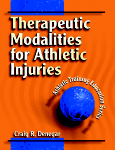Therapeutic
Modalities for Athletic Injuries
"Up-to-date,
research-backed information in a clear, organized fashion" |
 |
Therapeutic
Modalities for Athletic Injuries
Editor: Craig Denegar
Publisher: Human
Kinetics (2000); 264 pages
Back
to podiatry books list |
Understanding
the “why” and “how” behind the various
aspects of clinical practice is one of the greatest challenges
of becoming a certified athletic trainer. In Therapeutic
Modalities for Athletic Injuries, learn the underlying
physiological and physical implications of therapeutic modalities
with this valuable text.
Therapeutic
Modalities for Athletic Injuries presents up-to-date, research-backed
information in a clear, organized fashion, integrating information
from the fields of anatomy, physiology, biomechanics, and
the basic sciences. The text provides a contemporary, scientific
approach balanced with the realities of day-to-day clinical
practice. And no other book on the topic examines persistent
pain and pain management, neuromuscular control, and tissue
remodeling in such depth.
Based
on his extensive clinical experience, author of Therapeutic
Modalities for Athletic Injuries, Craig Denegar encourages
students to integrate their understanding of tissue healing
and pain with the physics and physiological responses to the
modalities discussed. Through case studies and three chapters
devoted to clinical practice, readers are introduced to real-world
challenges and solutions. They will discover that the use
of therapeutic modalities is just one part of the rehabilitation
process rather than the definitive treatment.
Therapeutic
Modalities for Athletic Injuries is filled with hundreds of
helpful photos, figures, and tables, and it features user-friendly
elements like objectives, chapter summaries, reading lists,
references, and a glossary.
Therapeutic
Modalities in Athletic Injuries builds a sound rationale for
the treatment plans that prospective athletic trainers will
put to good use throughout their careers.
Chapter
1. Therapeutic Modalities in Athletic Training: Contemporary
Use and Current Issues
Legal
Aspects of Therapeutic Modality Application: Practice Acts
and Negligent Treatment • The Rehabilitation Plan of
Care
Chapter
2. Psychological Aspects of Rehabilitation
Psychological Response to Injury • Maximizing Compliance
With a Rehabilitation Plan of Care • Barriers to Successful
Rehabilitation • Clinical Outcomes and Efficacy of Therapeutic
Modalities • A Word About Placebo
Chapter 3. Tissue Injury, Inflammation, and Repair
Healing Tissues and Inflammation: An Overview • Acute
Phase of the Inflammatory Response • Repair Phase of
the Inflammatory Response • Maturation Phase of the
Inflammatory Response • Chronic Inflammation •
Swelling • Joint Effusion • Swelling in the Lower
Extremity Due to Venous Insufficiency
Chapter
4. Pain and Pain Relief
What Is Pain? • Pain and the Physical Exam • Sensory
and Affective—Motivational Dimensions of Pain •
Persistent Pain • Perception and Sensation • Afferent
Pathways • Higher Centers • Synaptic Transmission
and Transmitter Substances • Pain Control • Why
Is Theory Important? • The Beginning of Contemporary
Pain Theory: Gate Control
Chapter
5. Persistent Pain
Finding the Cause • Depression and Somatization
Chapter
6. The Impact of Injury and Pain on Neuromuscular
Control
Neuromuscular Control and Muscle Atrophy • Why Is Neuromuscular
Control Lost? • The Role of Therapeutic Modalities in
Restoring Neuromuscular Control
Chapter
7. Cold and Superficial Heat
Energy Transfer • Cold Application • Superficial
Heat • Heat and Cold: Contrast Therapy • Heat,
Cold, and Contrast Therapy: Deciding What to Apply
Chapter
8. Electrotherapy
Basics of Electricity • Parameters of Electrical Stimulation
• Transcutaneous Electrical Nerve Stimulation (TENS)
• Iontophoresis • Direct Stimulation of Denervated
Muscle • Microcurrent
Chapter
9. Ultrasound, Diathermy, and Electromagnetic Fields
Thermal Effects of Ultrasound • Non-thermal Effects
of Ultrasound • Phonophoresis • Efficacy and Contraindications
to Ultrasound Diathermy
Chapter
10. Mechanical Energy
Manual Therapies • Traction • Intermittent Compression
Chapter
11. Treatment Plans for Acute Musculoskeletal Injuries
Rest, Ice, Compression, Elevation • Modalities
Used in Addition to RICE • Repair Phase • Maturation
Chapter
12. Neuromuscular Control and Biofeedback
Biofeedback • Clinical Applications: 1. Restoring Control
of Volitional Contraction • Clinical Applications: 2.
Functional Progression • Learning Relaxation
Chapter
13. Clinical Management of Persistent Pain
Treating Persistent Pain • Diagnosis and Plan of Care
Problems • Interrupting a Rest–Reinjury Cycle
• Evaluation and Treatment of Myofascial Pain Syndrome
• Treating Complex Regional Pain Syndrome • Depression
and Somatization
Back
to podiatric book list |
Orders:
Secure purchase
Therapeutic Modalities for Athletic Injuries
here in conjunction with 
Click
on your flag to order: |
| USA customers
click here: |
|
|
|
How
safe is buying online?
It is safer to pay online than it is to give your credit card
to a waiter at a restaurant. ePodiatry’s partners use
encryption technology to convert your personal account details
into a secret code which is sent over the internet. Anyone
trying to crack the code is looking for a 1 in 1,099,511,627,766
combination! ePodiatry does not have access to your personal
information from our partners.

Amazon.com
is based in USA, Canada, UK, Germany, France and Japan. They
offer an excellent level of service and reasonable shipping
charges to clients in countries outside of these (especially
Australia, New Zealand and South Africa).
In
addition, ePodiatry offers a guarantee of
a full refund if not satisfied when Therapeutic Modalities
for Athletic Injuries is ordered when clicking on one
of the flags above to place your order.
Back
to podiatric books list |
Links
of relevance to Therapeutic Modalities for Athletic Injuries: |
"Up-to-date, research-backed
information in a clear, organized fashion" |
Therapeutic
Modalities for Athletic Injuries
|

